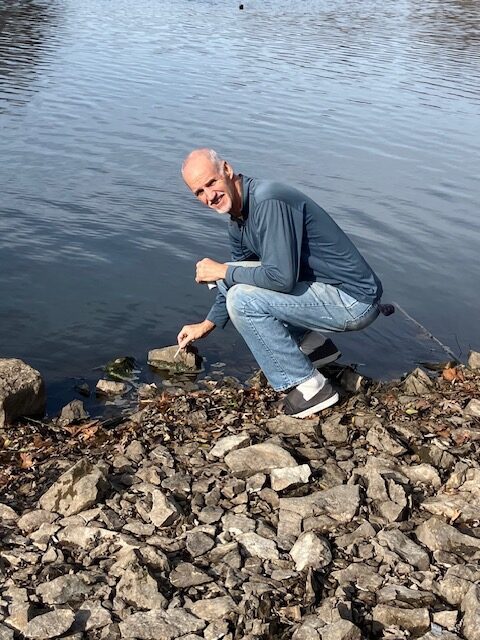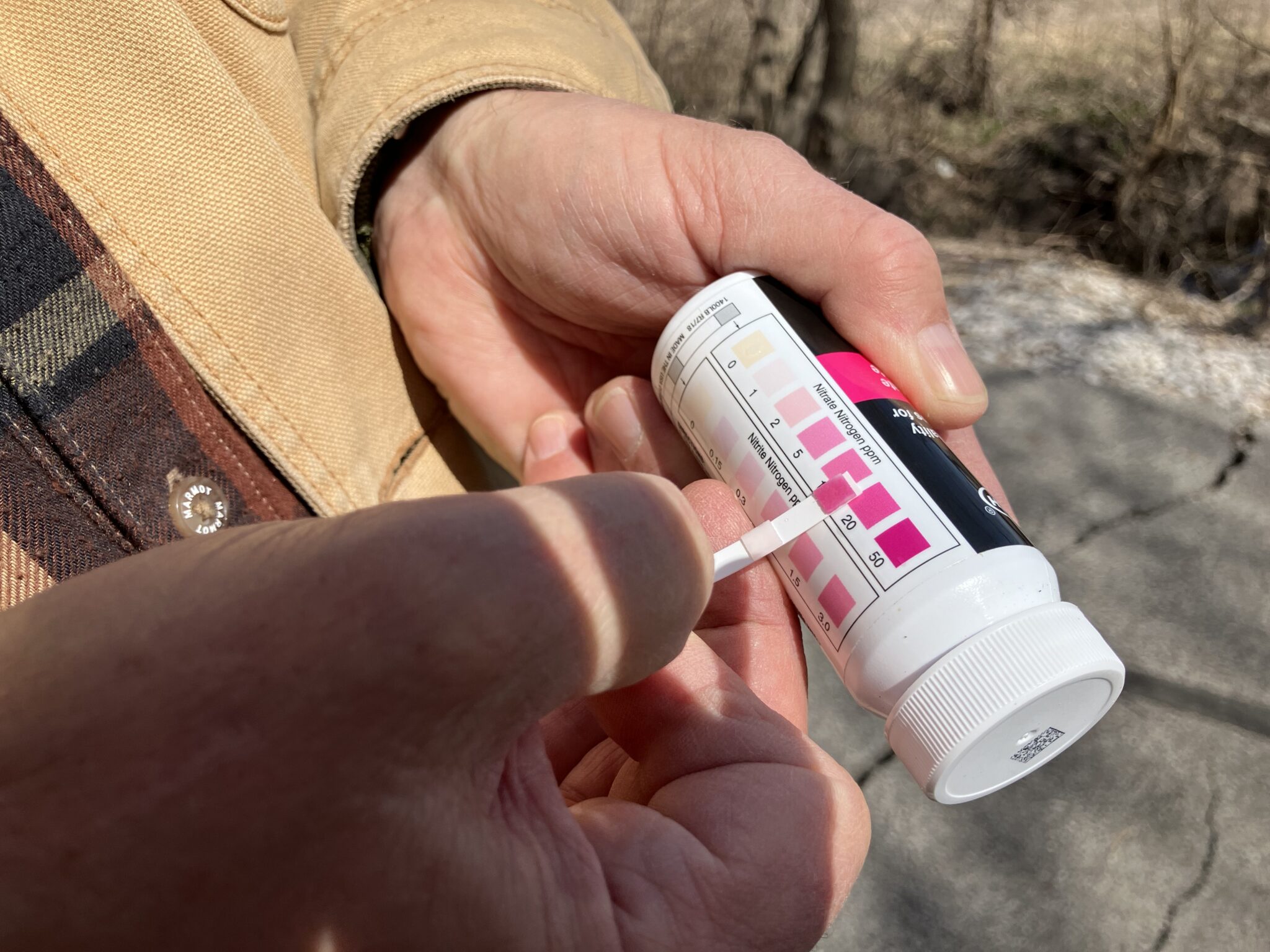Perspective
Can Men Help the Climate by Eating Less Meat?
Climate•5 min read
Feature
Amid rising cancer rates, citizens are demanding Governor Reynolds take more meaningful action.


Words by Nina B. Elkadi
Rich Gradoville, a retired schoolteacher, was perplexed by his bladder cancer diagnosis. He doesn’t engage in one of the highest risk factors for developing bladder cancer — smoking — so he asked his urologist what else might have caused it. His doctor told him that it could have a little something to do with living in Iowa. Some researchers and citizens worry that farm pollution is behind Iowa’s rising cancer rates — and despite what city officials say — their contaminated tap water shows that the pollution has made it into their kitchens.
Gradoville lives in Johnston, Iowa, a city of approximately 24,000 people. Iowa has been making headlines for its alarming cancer diagnosies rates, which are rising instead of declining like the rest of the country. A new partnership between the Iowa Environmental Council and The Harkin Institute has embarked on a project to fill research gaps into what connection there is, if any, between cancer and agriculture, including nitrates.
The nitrates that contaminate the water supply come largely from nitrogen-based fertilizer (either by way of manure or synthetic chemicals) over-applied to cropland. In Iowa alone, livestock operations are responsible for 109 billion pounds of manure each year. Nitrogen that does not get absorbed by crops turns into nitrate, and leaches into drinking water statewide. Nitrate exposure is linked to multiple health effects, including, potentially, cancer.
Many farmers over-apply fertilizer with the knowledge that some might be lost to rain or other weather events. And climate change is increasing the frequency of deluges and other extreme weather, resulting in catastrophic fish kill events from manure spills throughout farm country.
A few weeks ago, the Central Iowa Water Works — an umbrella organization for multiple water utilities, including Johnston — issued a mandatory lawn watering ban due to high levels of nitrates in the source water. The ban is now slowly being lifted, with a warning that the agency will keep an eye on levels.
While Gradoville has always had the water bug — wanting to swim in any creek he passes by — his willingness to jump right in has changed throughout his lifetime in Iowa.
“Over the last 15 years, I’ve been cautious about getting into our ponds and rivers and lakes here in Iowa,” he tells Sentient. To him, it makes sense that his bladder cancer diagnosis may be connected to water quality. A 2019 paper links bladder cancer incidence with nitrate-contaminated drinking water, but like many exposures, some researchers urge caution in drawing conclusions as to definitive causes. “I drink a lot of water because I donated a kidney seven years ago. I’ve always been instructed over these last seven years to drink a lot of water, and so it made sense that the bladder would be the starting point for all of that.”

The Des Moines metro area is home to some of the most state-of-the-art nitrate removal technology in the world. The Des Moines Water Works built the world’s largest nitrate removal facility in 1992, and since then, it has been consistently upgrading or changing the process to meet an increased demand. The nitrate removal system costs anywhere from $10,000 to $16,000 to run each day, with taxpayers footing the bill via their water bills.
This summer, running the facilities alone has not been enough to ensure clean water. The mandatory lawn watering ban has prompted citizens from across the state to urge Iowa Governor Kim Reynolds to take action. At a groundbreaking ceremony for the Italian-American Cultural Center in Des Moines in July, Governor Kim Reynolds told the press that regulation is not the answer to fixing nitrate pollution. “I can’t control Mother Nature,” she said.
“It surprised me that she would say that regulation is not the answer, because I think she’s been very comfortable using it in a lot of other areas,” Gradoville says, referring to new restrictions on what can be taught in Iowa schools. So, in lieu of government action, Gradoville has hit the river himself, with a makeshift contraption to test the nitrate levels in his own community.

Central Iowa Water Works maintains that drinking water coming out of taps is safe to drink, writing on July 14 that “All water produced by Central Iowa Water Works continues to meet all safe drinking water standards.”
Each Monday, Gradoville heads to two rivers. One of these is the Des Moines river, one of the sources of drinking water for the Des Moines Water Works. He uses a rake handle with the rake broken off, and rubber bands to hold a nitrate test strip in place where the rake itself used to be. He matches the color of the test strip to a key, and makes note of the results.
“Des Moines Water Works said the nitrate levels on the Raccoon and Des Moines were going down. My tests for the Des Moines River weren’t really matching up with that,” he says. Nitrate levels can fluctuate very quickly, depending on rain, water temperature, and many other factors. Gradoville also tests the water out of his faucet in Johnston. That has been testing great. “Once over the two years, it might have gotten in that four to five [mg/L] range, but usually it’s more in the one, two or three [mg/L] range.”
Gradoville contributes his data to Nitrate Watch, a program run by The Izaak Walton League of America, a conservation non-profit. He heard about it through Iowa Citizens for Community Improvement, a non-profit group that advocates for clean water. His data is added to an online database, which pinpoints where testing has occurred and plots the results over time.
The database contains some tap water results high above the EPA limit. On June 2, one Des Moines office building tested at 11 mg/L. On July 9, a home in the River Bend neighborhood of Des Moines tested at 15 mg/L, five mg/L above the EPA Safe Drinking Water standard. On July 11, Hubbell Tower Apartments, located in Des Moines, tested at 15 mg/L. One June 30, one home faucet in West Des Moines was producing nitrate levels at 20 mg/L.
Central Iowa Water Works told Sentient to reach out to Des Moines Water Works for comment about the high nitrate level points, and at the time of publication they have not responded.
Two days before lawn watering was banned, Polk County released a report on the detrimental water quality of the Des Moines and Raccoon Rivers, the sources of Des Moines drinking water.
“As an agricultural state with 70% of its land area in row crops, most of Iowa’s water quality problems originate from nonpoint sources,” the authors of the report write. Under the Clean Water Act, non-point sources, which include concentrated animal feeding operations (CAFOs) and cropland, are unregulated.
“Just because Reynolds doesn’t like regulation doesn’t mean it isn’t the best solution,” Food & Water Watch Iowa Organizer Michaelyn Mankel tells Sentient, referring to the Clean Water Act loophole, which exempts nonpoint sources of pollution — which includes field crops and concentrated animal feeding operations — from direct regulation limits.
“Voluntary programs to date have not resulted in the improvements necessary to meet CWA goals,” the authors of the Polk County report write.
While the Polk County report stops short of explicitly recommending regulation, it does state that voluntary practices are not making sufficient improvements to water quality.
Plus, the state has been giving voluntary practices a good try for the past 90 or so years, Iowa Environmental Council Staff Attorney Michael Schmidt says. Conservation practices, while increasing in the state, are not enough to keep up with the rate of destruction.
“We are offsetting that conservation through more animals in animal feeding operations and increased fertilizer sales and increased tile drainage,” Schmidt says. “Iowa has been adopting more conservation practices, but we’ve been more than offsetting that in other ways.”
In 2015, the Des Moines Water Works sued multiple counties upstream for polluting waterways. The state dismissed the suit in 2017. In 2021, non-profit advocacy groups Iowa Citizens for Community Improvement and Food & Water Watch sued the state for its failure to protect the cleanliness of the Raccoon River. The state supreme court struck it down.
The Central Iowa Water Works, which is an umbrella organization for multiple water utilities in the Des Moines metropolitan area, has plans to expand one of its nitrate removal facilities in Saylorville, Iowa. The project will be funded through State Revolving Fund loans, which ratepayers will fund through the life of the loans, Central Iowa Water Works Executive Director Tami Madsen confirmed to Sentient via email.
Increasing treatment capacity is “just a band-aid on the problem,” Schmidt says. “The sources are externalizing those costs downstream.”
Mankel, a Des Moines resident, notes that expanding infrastructure may not even solve the problem, and residents are worried.
“I think a lot of people don’t realize that nitrate exposure is a big risk over long periods, and that the longer you’ve lived in Iowa, the higher your risk is,” she says. “I think the biggest case for urgency that I can point to is the rate of incidence of cancer, and particularly the rate at which Iowans are dying from cancer,” she says.
For residents concerned about their drinking water, Schmidt advises against stocking up on bottled water, which is not necessarily free of nitrates. And boiling water, Mankel notes, can increase the concentration of nitrates, not decrease it. A reverse osmosis filter is the best way to ensure nitrates are filtered out, but they come at a steep price point.
“If you’re feeling afraid or you’re watching your loved ones or your colleagues or your neighbors suffer from rising cancer rates, or these other things that are tied to agricultural pollution, you don’t have to do that alone,” Mankel says.
For Gradoville, sticking his makeshift nitrate-test-receptacle in the Des Moines river was a no-brainer.
“I can’t think of anything much more important to a good, healthy life than clean water,” he says.
Last fall, on a vacation up in northern Minnesota, he remembers the water the most.
“It was just so pleasant to see the stream that was going through, and the lake, just how clear and inviting the water was,” he says. It’s not like this everywhere, he adds. It doesn’t have to be this way.